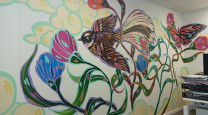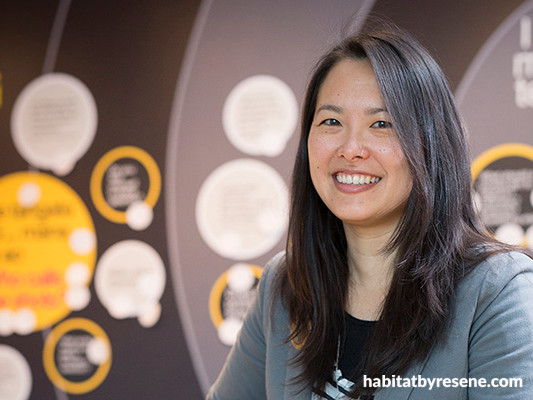
Crafting time and space: Rosanne Kwan's design journey at Te Papa
22 Jan 2024
Rosanne Kwan is Te Papa's talented Spatial and 3D Designer. Her passion lies in crafting physical spaces that immerse visitors in compelling narratives. With a career spanning a decade, Rosanne shares her journey from early days in exhibition design to her current role. Her work on the latest exhibition, Ngā Taniwha o Rūpapa - Dinosaurs of Patagonia, is highlighted, where she strategically incorporates Resene colours like Resene Double Fossil, Resene Craigieburn and Resene Atlas to evoke different eras.
Tell us about your work and your role as Te Papa’s Spatial and 3D Designer.
“I just love having the opportunity to craft physical spaces where people can engage with different stories and ideas. In my role we build on the exhibition concepts by adding layers of interpretation throughout the space, and we can influence people’s enjoyment, understanding or experience through our design, so that is rather special. We also get to see some pretty cool stuff and work with some pretty awesome people.”
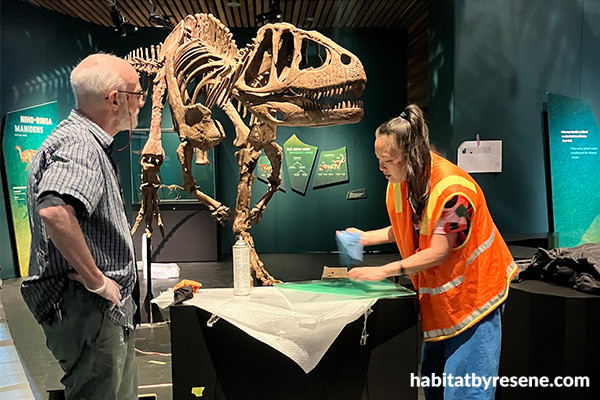
Rosanne during the installation of Ngā Taniwha o Rūpapa - Dinosaurs of Patagonia.
What has your career path been like to get you to this role?
“I started in exhibition design very early in my career when specialisation in this field was probably in its infancy. I studied interior design in Sydney, and very fortunately landed a work experience role at a relatively young design company that focused on exhibition design. I loved it so much that I stayed on after graduating and built my career from there. We did exhibitions all over Australia and even a few in New Zealand, which planted a seed for my future move over here. I later travelled and worked for other design agencies, but I ended up gravitating back to exhibition design as it is just the most satisfying place to be. I then became a designer at National Museums Scotland in Edinburgh, later the Powerhouse Museum back in Sydney, and at the start of 2014 I took on my role at Te Papa, so that’ll be nearly 10 years I’ve been here now, and I’m still enjoying it!”
What does a typical day look like for you?
“Depending on where in the project we’re at, I might be listening to experts talk about their subject matter, looking at a selection of objects and figuring out how best to display them, working with multi-disciplinary teams to create new experiences for visitors, planning out a whole exhibition space on my computer, detailing up furniture and joinery right down to the nuts and bolts, or quite literally on the floor installing an exhibition.”
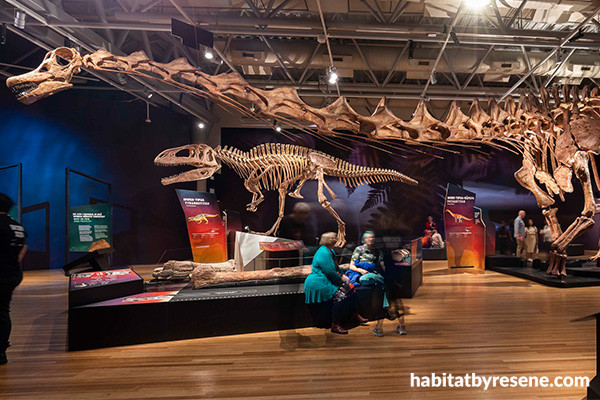
Rosanne’s completed exhibition at Te Papa - Ngā Taniwha o Rūpapa | Dinosaurs of Patagonia.
Tell us about the exhibition at Te Papa and the use of colour to showcase the designs.
“Ngā Taniwha o Rūpapa | Dinosaurs of Patagonia is unfolded chronologically over the Mesozoic era and we wanted to immerse visitors in a sense of each period. There’s also an underlying thread following dawn, day, dusk, adding to the sense of the passing of time. But the dinosaurs are the absolute stars of the show, set against a backdrop of colour, graphics and lighting effects that were inspired by our understanding of the flora of the time.
Fittingly, we start with Resene Double Fossil as we introduce the exhibition. The visitor is pulled in towards a large projection setting the scene of the dig site where the Patagotitan was discovered. Right up front, there is a gigantic fossil bone, showing a glimpse of just how huge some of the dinosaurs came to be.
Entering into the dawn of the dinosaurs, Triassic is painted in the deep sandy desert colour Resene Craigieburn, complemented with warm tones through the graphics, as the environment predominately hot and dry, with deserts spanning much of Pangaea's interior.
The Jurassic Period was characterised by a warm, tropical climate and abundant vegetation. We chose Resene Atlas, a luscious forest green, to signify this flourishing of plant life, which provided favourable conditions for the dominance and proliferation of dinosaurs. To connect the exhibition across two very separate spaces in the museum, designer Crystal Jones created a “forest” of coloured tubes in varying shades of green. We used a paint wash technique to create more variation in tones while keeping the overall look cohesive.
The Cretaceous Period is when flowering plants first appeared and became abundant. Our design continues with the lush theme but takes on a softer form, and Resene Zeppelin, a dark moody violet hue, provides a rich backdrop to the majestic cast of the Patagotitan, the largest animal known that walked on earth. We also have large projections which work incredibly well over this deep colour, integrated behind the dinos with gobo lighting, bringing the Patagotitan to life. Most of the painted areas are finished in Resene Zylone Sheen or Resene SpaceCote Low Sheen which helps to add extra depth to the colours.
As we exit, we learn about a mass extinction event and we are plunged into the sooty darkness of Resene Chimney Sweep, but we leave the visitor with an opportunity to connect and wonder, are dinosaurs still with us, in a way?
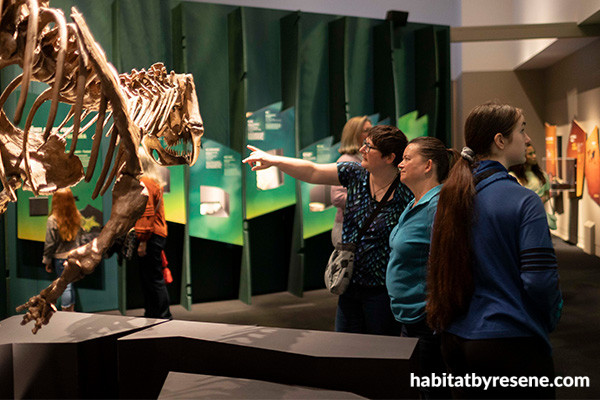
Visitors at Ngā Taniwha o Rūpapa | Dinosaurs of Patagonia at Te Papa. Showcasing the lush green of Resene Atlas and Resene Craigieburn behind the installations.
What is your favourite Resene colour?
Honestly, it depends on how the colours get used, and they can all have their moments. One that we used in the Surrealist Art exhibition was called Resene Gothic. It was a dusty, complex blue and we coloured the entire space with it – walls, showcases, floors and all, and it had this sense of depth and endlessness. As the final segment of an already immersive journey, it felt like a celebration and retrospective in one.
The colour proved to be a hit with the public, as we had more than a few visitor enquiries for it. We tend to make some pretty bold colour choices at times in exhibition making, but I can see this one being quite versatile, as much at home in a serene bedroom or a fresh breakout space perhaps.
For more information about Te Papa and the current exhibition, visit Dinosaurs of Patagonia | Te Papa.
Published: 22 Jan 2024




